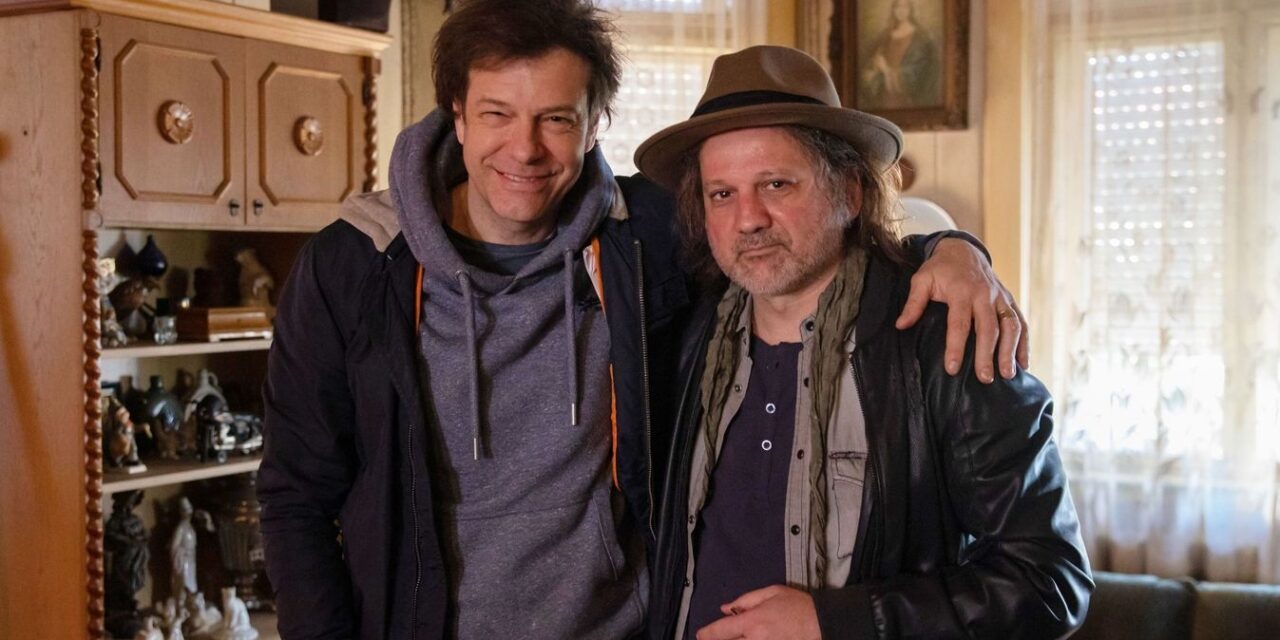The reporter, presenter, and filmmaker also tells about his own liberation story in connection with his new film. Interview by Anita Farkas.
Attila Till's new film starts out brutally, but turns into a touching story of liberation and gives hope to everyone. And what about Tom? he talks at the same time about the pitfalls of alcohol addiction, the hell of those involved and their relatives, and the fact that there is no darkness where the sun does not sometimes shine.
The first fifteen minutes, with the brutal physical and mental crushing of the head of the family coming home drunk, are eerily authentic, unfortunately I speak from experience.
It is very interesting because anyone who has seen the film so far has found a similar personal involvement in one of its parts. The first reaction of those who haven't seen it yet is that they definitely won't miss it, because they have something to do with the topic either through themselves or through their environment. As I talk more and more about it with more and more people, the booze-related stories of friends, brothers, parents, and at least one uncle, who drank heavily at every family dinner, often bubble up from the depths. And, of course, the pain immediately follows. Alcoholism is not only a trauma for the person who drinks, and either fights with this addiction, or first gets ruined by it, then dies, and then the matter is pretty much over for him.
The family members, the children who have grown up in the meantime, carry with them the damage they suffered indirectly for a lifetime, stepping into the exact same river more than once.
When we think of alcoholics, most of the time we see degenerate men, and in terms of the issue, this cinema is also strongly male-oriented. Did they intentionally not touch on the issue of female alcoholism?
I don't think it's a less serious problem, especially because of its invisibility, which is much more characteristic of women. But on the one hand, my goal was not to give a complete inventory of alcoholism. On the other hand, since I am a man, I can obviously make a man's film more authentically. If we observe, female directors always have more female characters, and they understand their portrayal better, since they are still more present in that universe.
That is, the And what about Tom? a decidedly male film?
In this regard, yes. Or if you prefer, a friendship film; The pair of Sanyi and Pali, i.e. Szabolcs Thuróczy and Tamás Polgár, have many ancestors or foreshadows going back to Stan and Pan. While their story is obviously not a joke in the first place.
For me, the message is more that the only way to escape from ourselves is to have someone to rely on.
Yes. Since the topic itself is quite depressing, we specifically wanted to show the solution options as well. In no way did we want to portray the tragedy in such a way that an alcoholic or an addict can only be a fallen person, with a kind of endgame: they fall into the abyss and die. Because that's not true in life either. There are many ways out, help and cures, from peer communities to psychologists to treatments in closed institutions. But I think, and that is my personal experience,
that, in the long run, the most effective are the helping communities, such as Alcoholics Anonymous.
Those who attend these are not necessarily friends - neither are Sanyi and Pali, who come from completely different social strata, in this sense - but really companions in the deepest and most beautiful sense of the word, who do not have to be ashamed of each other for anything. You have to imagine it a bit like Christians in churches, Jews in synagogues, Muslims in mosques: the cohesion between them is very strong, they almost see each other as brothers. However, I would also add right away that all external or peer help is useless if the most important thing is left out.
What is it?
Individual responsibility. The deepest self-examination, self-mutilation, during which we honestly and cruelly look into our own face. If someone can really do this work, and is able to see themselves differently, and then shed the skin of the addicted or alcoholic self like a snake with a lot of effort, there are few more fantastic feelings in life.
Can you tell me firsthand?
Yes.
Was he an alcoholic?
I still am today. It's a cliché, but that's why it's true: a person who was an alcoholic will remain so for the rest of his life, regardless of whether he still drinks or not. It could be refined that I was not such a serious case, but it doesn't make much sense. If alcohol has made my life difficult in any way, then I am. It helps me now that I'm not forgiving of myself. I haven't even smoked in a few years. And in connection with the film, I also visited AA meetings, I felt very comfortable in their company. The possibility of slipping up, of deviating from the right path, hovers in the background for the rest of your life.
Now the situation is that I haven't had a sip in years, the middle ground doesn't work for me.
Did you decide to do so as a result of some sort of reverse mid-life crisis?
I have not experienced any crisis. In the first place, I think, the person who has never pushed anything too far before is able to completely lose his temper in his forties and suddenly change everything around him. To put it mildly, this wasn't typical of me, I really partied myself. But it's true that quitting and then, when I started fighting the elements in a new universe, came with cathartic realizations. I experience the whole thing as a kind of liberation story, and I tried to tell such a liberation story in the film as well. Mixing my own experiences, feelings, and experiences with many other people and, of course, a lot of fiction.
And, although the inventory is not complete, it also shows many types of alcoholism. It is always a matter of debate who actually counts as an alcoholic.
This is the trickiest thing of all, that alcoholism can have many different faces: some people degrade themselves to the point of being unbearable in a matter of seconds, others hold on for decades, there are those who become totally aggressive with a little booze, others need to be beaten to the limit in order to finally knock themselves out. For example, I was the typical heavy drinker who, once it goes into the night, can't stop for two days - like a car that runs until it runs out of gas. At that time, my personality also completely changed, I escalated to infinity in both good and bad ways, and after a while I became not only a lot, but downright unbearable for those around me. At idle, at least that's what people say, I'm quite pleasant company, but everyone would be shocked if they saw where I go crazy after a bottle of vodka. And this is the point of it all:
everyone can drink, do drugs, do anything as long as it doesn't harm themselves and their environment.
Another question is whether we ever recognize this point, our unbearableness, or whether it is always someone else's fault.
Yes. Fortunately, I managed somehow. And I simply decided that I didn't want to live like this anymore. I don't want to wake up drunk anymore, sit in all kinds of places with a hungover head and full of injuries, I don't want to apologize for what I said or did the night before, I don't want my wife to worry about me all night, like my parents did when I was a teenager, I don't want to feel guilty about him and our children.
And I don't want to burn at that level anymore. Before that, I was constantly looking for this feeling: to burn until I somehow disappeared, absorbed, erased from my own life. That's why I drank from about the age of fifteen. And from a party, from pleasure. You are not out of anxiety because my existence would have depended on it. Perhaps this is the main reason why it was relatively easy for me to stop compared to many others. And behold a miracle, since then I realized that the world is quite colorful and interesting even when sober.
He started relatively early. Was there a home sample?
There were one or two hard alcoholics in the extended family, but my parents were far from that. There were sometimes stories about my father as a heavy drinker in his youth, but otherwise they drank like the average, pouring a beer or two for each other on occasions or in the evening. If you put it that way, almost all of us have some kind of pattern to it;
mind-altering drugs are as old as humanity, it seems that we need them in some form at all times.
Moreover, among them, alcohol is traditionally the most allowed, which you can get anywhere, and your dealer is practically your father, mother, brother, friend, the publicist, the cigarette shop. Not like all the other stuff that you have to pick up expensively in stupid places, worried about being dropped. How much and in what depth we deal with this topic: how many victims alcohol addiction takes and what could be done to reduce the numbers, varies from culture to culture.
How are we doing here in Hungary in this field?
There is a duality. Many civil organizations raise similar issues, but in general the matter is swept under the carpet, saying, children, everyone drinks, let's turn the page, there are bigger problems here.
While, according to WHO data, we are among the world leaders in drinking, and although we do not drink the most alcohol, we have the highest proportion of alcoholics and problem drinkers compared to the total population. That could just set off the alarm.
It is not good that we are a country of a million alcoholics, but I do not think that we are worse than others; nor do the British or the Scandinavians skimp when it comes to drinking.
The difference is that, with us, the national sport itself is presented in a worse light than it really is, downplayed and devalued.
We constantly analyse, argue and judge, while preferring to push the real problems into the background. This is also perfectly reflected in the social attitude towards alcoholism. In such cases, family members are often stigmatized as well, as if they are responsible for the bad decisions of an adult. However, as I said before, the issue of individual responsibility can never be avoided in this regard.
Because everyone has problems and even brought or acquired traumas, but not everyone runs away from them into some sort of addiction.
This is a very far-reaching thought, what makes someone addicted, while others, even with a much bigger package of problems on their back, do not; scientists say genes have a massive role to play. Returning to the film, we also tried to show in the character of Sanyi that even though we often know and feel what causes our blockages in life, it is almost as difficult to articulate this as it is to say out loud for the first time that "I am an alcoholic".
Because here is this puppeteer in his fifties, whose greatest tragedy is that he remained a child; it is not by chance that his profession is what he is, and it is not by chance that he constantly carries his small stuffed animals in his side bag. He was stuck in the role of the great artist's little son, and he never dared to step out into the light on his own, because he knew that he was not that good, even as a puppeteer, he only got the role of the sixth rabbit in the shadow of the young people panting around his neck. We could also say that he is destined to be an eternal loser.
But I like to believe that fate is not destiny, and that in everyone's life there is the possibility of redemption.
You don't necessarily have to think about big things, this isn't Hollywood, our Sany won't be rich and successful at the same time either. However, by finally asking for help, saying what he needs to, and no matter what happens, he can always last "one more day" without alcohol, yet he becomes the hero of his own life. I think this is precisely the hopeful beauty of this cinema. That it can indeed succeed: we can fight our way back to normality with great strength.
And how to feel about it, everyone's heart is in it.
That's right. For Sanyi, puppetry is sacred, for me it is the film. Maybe because I like to be in a community, and filmmaking is always a social game with a strong emotional charge. Now that the domestic film environment has completely disintegrated into state-supported and unsupported films, it is even more so. In recent years, I have applied to the film institute with several projects, but they have always been rejected. So I understood, together with others, that there is nothing to wait for. No matter how difficult it is to raise the money, asking friends and acquaintances for free work again and again, you have to do it. Because if we don't, it's even worse. And I don't want to be an embittered Sanyi who doesn't do anything, at most sometimes yells from behind the screen.
Featured image: Attila Till and Szabolcs Thuróczy in And what's with Tom? on the set of the film. (Péter Nemesházi/Laokoon Filmgroup)













